07 September 2006
The Journey Home
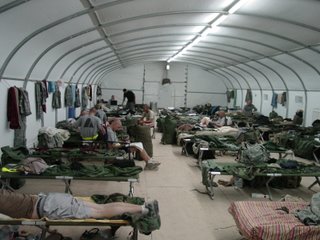
The customs inspection that morning went without a hitch. Another gate was passed on the journey back home. Soldiers then cleaned and cleared the tents at our temporary housing location. We then drew our weapons and went to an accountability formation. Because of the large number of soldiers in our chalk (around 300 or so), we had to have the accountability formation outside. By that time (1330), it was quite warm out, probably around 120 degrees. We had to do sensitive item serial number checks and confirm that each soldier present had his ID card and dog tags. By the time we finished, the busses were suppose to be there to take us to the next stop. By my use of the phrase “suppose to,” you probably guessed that they didn’t show up on time. So, we waited in the sun for about another half hour before we “reclaimed” our cleared air-conditioned tents. By then, we were all drenched with sweat. Even the tops of my boots were wet from the sweat seeping through (yeah, I know, gross).
The busses showed up eventually and took us to our next destination. We received some briefings and they inspected our ruck sacks and our persons. Even though this was a charted flight (our unit only), with a couple of notable exceptions, we were subject to the same carry on restrictions as civilians who travel—i.e., no Leathermans/Gerbers, liquids, deodorants, sharp objects, etc. It created a perverted situation for us. Specifically, for myself, I wasn’t allowed to bring on a little tube of toothpaste, my deodorant, or a cup of coffee on the aircraft, but I was able (and required) to carry my M9 semi-automatic pistol and my M4 carbine automatic rifle. Go figure. It probably makes sense to someone, somewhere though.
The briefings and ruck inspections finished around 1730 or so. We then sat in a holding area for about six hours before being told that our aircraft was delayed. I’m not sure what the on-time percentage is in the civilian world, maybe 75% if I had to guess, but in the military world it’s got to be less than 10%. Most of the flights, like this one are actually civilian contracted carriers, so I’m not sure it’s a “military” issue. None of my six flights going to and from the States was within three hours of being on time of the scheduled departure. Others with whom I spoke have had similar experiences. I’m not sure what the deal is (perhaps a lowest bidder and/or lowest priority issue?). At this point, most soldiers expected it and most, like myself, were just glad to be getting home, eventually.
So, around 0200 we formed up at the holding area, were given another brief, and got on another set of busses to go to yet another holding area located near the Kuwaiti international airport. We arrived at this holding area at about 0330. We were fast approaching the 24 hour mark since we got up that morning. Virtually everyone was on adrenalin: trying to sleep or relax, but the excitement of returning back to the States was too great for most.
We waited at this holding area for about another hour before getting back on the busses and heading to the aircraft. The aircraft was an MD-11. I was spoiled and had the benefit of sitting in first class. The seats were absolutely wonderful, better than any other first class seats I had ever been in (well, the 4-5 times I’ve been bumped up to first class, anyway). They reclined way back and the seats had foot rests like a recliner sitting at home in the living room. Each seat had a personal monitor that lifted up from the arm rest. These were so nice that I felt a little guilty that everyone couldn’t sit in them. We waited on the aircraft for about 45 minutes of so and were able to watch our last Middle Eastern sunrise for this mission.
Our first stop was Lietzsig, Germany. We arrived there at about 1000 local time. Not much of an airport (or at least the part where we segregated to). There was a convenience store there and that was about it. It was the first time I had ever been to Germany. I bought some toiletries to replace what I was initially precluded from carrying onto the aircraft. Our Battalion Command Sergeant Major let the guys purchase a couple of beers from the convenience store, which was nice. It had been several months for most soldiers since they had had their last beer. After about an hour and a half, we took off for our next stop, which was Bangor, Maine.
Most of the trip over the Atlantic was cloud covered. As we made our descent into Maine, we broke through the clouds and saw an incredible sight: TREES! They were everywhere. Thick, green, lush. Oh, was it beautiful. I think there was a collective gasp on the aircraft when we initially made it through the clouds and saw all the vegetation. It was so green.
As I suppose is to be expected, when the wheels touched down in Bangor, the soldiers erupted with cheers, clapping and whistles. Another box checked in the long-anticipated milestones before getting back to Wisconsin. We were on American soil now. The time was about 1300 local (2000 Middle East time or 40 hours since we woke up before the customs inspections).
As was the case about a year ago when we were headed in the opposite direction, we were greeted very warmly by the people of Bangor. I must have shook the hands of about 50 locals. They greeted each of the 300 or so soldiers on our aircraft. People all over in the entire airport applauded as we came out. What a great group of people. What a great way to come home to the U.S. It really made all of us feel good. I’m frequently told by Viet Nam vets of the stark contrast that they experienced. After we made it through the lines of people, we were handed cell phones to call our loved ones back home to let them know that we had arrived safely back in the States. The cell phones were paid for by a local Maine group. Below are some pictures. Unfortunately, I don't have any of the welcoming line. I was too busy shaking hands!

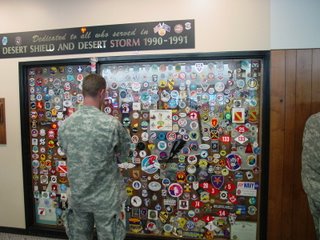

After we said our goodbyes and shook the hands again of the various people who greeted us in Bangor, we headed off to our final destination that day, Volk Field, Wisconsin. Despite having been up for almost 42 hours straight, the level of excitement in the aircraft was pretty high as we began that last leg of our journey. We were fairly excited about seeing our loved ones, being back home, and finally (and successfully) completing our mission overseas. It had been a long journey.
They integrated our landing in Wisconsin with an airshow that was going on at Volk Field. The pilot over the intercom explained the situation as we descended. We could see the cranberry bogs of west-central Wisconsin as we continued to descend. The trees, vegetation, and cars came into focus. We could see the rolling hills and textured earth. Good memories were recalled more vividly. Everything became more real. And then we saw the runway as the wheels reached for it. After a pause, we heard the screech of the tires touching down. They were immediately drowned out by cheers, roars, and whistles of the soldiers inside the plane. We saw the crowds of people outside of the plane waving their hands, jumping up and down and proudly showing their home-made signs welcoming us home. What a feeling. I thought for a moment about our lost soldiers and their families who weren’t with us to savor the moment, the feeling. After a couple of minutes the doors of the aircraft opened. The cool, fresh Wisconsin air rushed in. We were finally home.
18 August 2006
RIP/TOA
As I mentioned in a previous post, we have been training our replacements for weeks. I was pleased at how committed our guys were to the training and transition process. I didn't see any of our NCOs or officers develop "short-timer" attitudes or take short cuts in the process. All were eager to train their counterparts in the incoming battalion (also from Wisconsin) and share their experiences. They knew the importance to the in-coming unit of that knowledge and experience and they knew the stakes. By the time of the RIP/TOA, the incoming unit was ready to take the mission and show their mettle.
The last of our men to cross the wire came back the day prior to the RIP/TOA. Because of space issues at Navistar, most of the battalion had already shuttled off Navistar to a camp in south-central Kuwait. Our RIP/TOA ceremony consisted of commanders, first sergeants, the command sergeant major, guide-on barrers, color guard, and certain staff officers from both battalions. It was a relatively short and simple ceremony. In his speech, our battalion commander reflected on the successes of our tour as well as our losses and sacrificies. The incoming commander thanked us for our training and transition time and challenged his unit to meet and hopefully exceed the milestones and goals that we set as a battalion.
This last year has been a long one that has gone quickly.
13 August 2006
Memorial Service
By the time I arrived, there were already about 200 soldiers there. We stood around for about fifteen minutes prior to the battalion formation. We engaged in somewhat awkward small talk, glancing at the soldier’s memorial display at every pause in the conversation.
This was the second memorial service in the last two weeks for us. Unlike the other ceremonies that were in the morning, this one was in the evening, which had an affect on the atmosphere. I think it was probably because there was more time during the day to think about the ceremony that evening. That particular evening was also different because of the humidity level in the air. The wind had changed direction for the first time in weeks if not months and was blowing moist air in from the Gulf coast.
We formed up, and the Generals and other dignitaries arrived. The familiar sequence started—the Star Spangled Banner, the invocation, followed by remarks from various people. The company commander spoke, the squad leader spoke and one of the soldier’s buddies spoke. Each talked of the uniqueness of the soldier, his selfless service, his commitment, his competence, and his virtually patented smile. Each of them shared personal experiences that they had with the soldier. Many of the experiences were funny or made me smile. The smiles were followed by sudden heavy and sharp feeling of hurt that I and others there felt from the loss of one of our own.
After the remarks and the recitation of the Fiddler’s Green (a Cav ritual), the NCO in charge of the 7-man firing squad belted out his commands to the firing squad. On his command of “Ready, Fire,” the squad fired in unison. A single loud “crack” echoed through the dense, humid air. There was a pause, then “Ready, Fire!” Again, the single loud crack. And finally once more, “Ready, Fire!” I can feel at will the tenseness in my neck and shoulders hearing those shots. Upon hearing the first volley, I anticipate the next, but yet for some reason I am still surprised when I hear them. The shots remind me of the abrupt, suddenness and finality of death.
After a silent moment, the bugler started playing a slow, mournful Taps. He was about 10 meters from me. I was there with my men behind me. I stood there rigidly; steady drips of sweat were falling down my back, my chest, my arms, my legs, and my patrol cap. I then heard about 100 meters away another bugler who also started playing Taps. They echoed one another. I was soon lost in thought about the soldier and his family . . . his youth, the finality of his death, the loss of the family.
At the conclusion of the ceremony, a recording of bagpipes played. As is customary, each soldier present paid his respects individually to the soldier who has given his life. A single file military line was formed. The over 700 soldiers present individually saluted the picture of the soldier, silently said something to or in remembrance of the soldier before saluting again and moving away.
These ceremonies are very well done, professional, and well-rehearsed. They are far from cold and impersonal. Many a soldier is seen shedding tears. There is no shame in it. They are tears of respect and caring. They are symbols of the brotherhood that has been established with others who you’ve shared common experiences with and with whom you share many values and beliefs.
These ceremonies are hard. I hope this one was my last one.
07 August 2006
Their First Mission
The looks on their faces were familiar. I recall the feelings that we had coming off those buses for the first time almost a year ago. A strange mix of excitement and caution and one of relief that “finally, finally, after all that training, we’re here.”
We started our cross-training of these soldiers right away; we gave them initial training on all the specialized and newly fielded equipment that we had not even heard of a year ago that we had become experts on during our deployment. We shared with them the stories of our successes, challenges, and some of our close calls and yes, our losses.
An integral part of the training of our replacements is taking them out on the road with us. It was on the first day of this training that it happened. An IED took the life of one of the soldiers we were training. It also seriously injured two of their other soldiers and one of our NCOs who was training them. It was their first mission. First mission. I don’t even know if these guys had their stuff unpacked yet.
The cross-training at my level went from how to defeat enemy actions using the latest tactics, techniques and procedures to how to notify next of kin, how to enforce a communications blackout, and how to keep soldiers motivated and mission focused after a fatality or serious injury.
Any soldier seeing combat over here who came with a preconceived notion that “life is fair” will get a rude awakening. Death and injury can come to the young and the old, the naïve and the experienced. It can come to those who do everything right and yet miss those who do most everything wrong. It isn’t fair. This notion wasn’t news to me, but I was reminded of it too frequently this last year and it has been hard for some of my soldiers to swallow and comprehend.
The realities of this war have not shaken my resolve though. They have not affected my love of my country nor my belief in the principles for which it stands. They have not diminished my belief that the Iraqis have been given a great opportunity that may positively affect several generations to come. I still believe that ultimately democracy will prevail over here, regardless of whether a painful civil war is to occur as our own nation had to endure for four long years. It will likely take time and unfortunately, it may come at a dear price. Perhaps at a price yet to be paid.
01 August 2006
Now That's Hot
We had an SP time of about 0800 in the morning for a mission that was anticipated to have two, three hour segments. We were going to try to start the second segment in the late afternoon in order to miss some of the hottest weather of the day. We did our maintenance checks before we left and everything looked fine.
We headed out on time and everything seemed to be working OK. The inside of the HMMWV gets rather hot from a combination of the engine temperature and the sun beating down on the roof of the vehicle. When the air conditioner is doing its job during the day of the summer months, the inside temperature of the HMMWV is about 100 degrees or so, which isn’t too bad. When the crews arrive at their destination, they are quick to shed their body armor, goggles, gloves, helmet, etc. Typically, they’ll sweat a lot but the air conditioned temperature is just a mild irritation. When the air conditioner doesn’t work . . . well, that’s an entirely different story.
About 20 minutes into our mission, the air conditioner in our vehicle stopped working (or as my driver put, “hey, the a/c crapped out on us sir”). It quickly got very hot. Because of IED and sniper threats, we have to keep the windows all the way up. There were a number of vehicle issues with the trucks on this mission. What was suppose to be a three hour leg of a mission, turned into 4 ½ hours. With the temperatures soaring as the day wore on, sweat was just pouring out of us. Our eyes were stinging. We had each gone through about 2 gallons of water and Gatorade in just under three hours. The outside temperature at the beginning of the mission was about 105, but by midday it was somewhere between 120-130. I don’t know what the temperature inside of the vehicle was by then, but it was much hotter in the vehicle than it was outside of the vehicle.
To keep things light, I started a top 10 list with my crew members. It went something like this: “You know the air conditioning in your vehicle in Iraq has gone out when . . . .” I can’t remember all the ones we came up with, but here are a few of them (all of which are true):
- When the gunner complains that the top half of his body is substantially cooler in 125 degree heat than the bottom half of his body that is in the vehicle.
- When you can’t rest your covered elbows, forearms or hands on any internal HMMWV component (other than the steering wheel, thankfully!) for more than 15 seconds because they are all too hot.
- When the three bags of ice in your cooler have all melted within a short time frame.
- When you get up out of your seat, the canvas seat cover is as soaked as if you had left the vehicle window open during a rain storm.
- When you take off one of your nomex gloves and your fingers are as wrinkled as if you had been swimming for the last hour.
- When you can’t hold your 9 mm with your bare hand more than three seconds because it’s too hot.
- And finally, you know the air conditioning in your vehicle in Iraq has gone out when you open the door and first step out into the 125+ degree heat, it feels like a spring breeze that is only surpassed by the feeling you get after taking off your body armor and getting a little chill down your wet spine.
25 July 2006
Have You Hugged an Historian Today?
I am not a history buff, nor have I ever had a desire to become one. But, I have been amazed at what I have learned over this last year. I used to think about history as just the facts and figures, peppered with some interesting stories. But it’s much more than that.
One thing I have gained from history is perspective. In some previous blog posts, I’ve mentioned or alluded to the perspective one gains from history in gauging an appropriate expectation level for today—for example, the time it has taken historically for democracies to be established as compared to our current time expectations in Iraq, which has been driven by our current cultural of immediacy.
I’ve also gained some perspective on sacrifice in my recent readings lately on military leaders of World War I. For example, on one day (July 1, 1916), the British army lost 20 times the number of soldiers, marines, and airmen than we’ve lost since Operation Iraqi Freedom started more than three years ago. That’s in one day. In one battle during World War I, the French lost more men than we currently have on active duty in the U.S. Army. I don’t state these facts to lessen the sacrifices of the soldiers in my unit or other units who we’ve lost or who have been permanently injured and/or disabled during the war over here. But our sacrifices now are not unlike those that have been made for centuries. In fact, our collective sacrifices today pale in comparison to those of previous generations. The sacrifices of the individual, his family and friends, though are often the same and a part of the realities of war, regardless of time.
In addition to perspective, my recent exposure to history has given me guidance. Most people have heard the adage that goes something like, “if you don’t understand history, you’re bound to repeat it.” In other words, it is important to learn from the mistakes of the past. But, the guidance that history has given me is more than that. It has given me the comfort of knowing that most problems and issues we face now (or ones similar) have been addressed in the past. And just as we have learned from the mistakes of the past, we should not take for granted the successes of the past as well.
Our position in the world, whether it be from a military or a freedom and democracy perspective, is far from being a permanent fixture in time. Borrowing again from the first half of the 20th Century, with the successes from a rudimentary form of sonar that was developed in World War I, the British thought they conquered any threat associated with submarines. Because of their early technological successes in defeating submarines, they shifted their attention to other matters (both military and domestic related). Come the advent of World War II, the British were left with a situation of virtual logistic isolation because of the successes of German U-Boat subs. Through tactics and techniques, the Germans were able to overcome a temporary technology advantage of the British. Churchill later said that that the U-Boat threat was the only thing that really scared him during the war.
Applying that lesson, I can see now how we have become very reliant on our technological advantage and our military edge and dominance. In some regards, we’ve repeated a mistake of arrogantly relying on our technological edge/dominance in a war with the Iraqi insurgency. It’s still strange to think how a nation would have any difficulty in a war without losing a single battle or engagement with its enemy at the platoon level or above. The insurgency’s successes have been almost entirely in the media and public affairs. They draw energy and support not in a war of attrition, which they are losing, but from their enemy (us) whose primary source of power is from its people. By having sensational IEDs, kidnappings, scenes of anarchy and bloodshed, etc., the American people’s support for the war has waned and insurgent-friendly groups/nations rally to their cause, both spiritually and financially. In the end though, I am still hopeful that we’ll be successful in turning this around like the British did against the Germans, regardless of whether our solution is a military or political one.
13 July 2006
For Sale

Centrally located in CSC Navistar, rustic 8 “room” condo, 2 years old, recently renovated, miles of beach front-like property (without water), over looking the famed Iraq-Kuwait border, just minutes away from local mini-mart, dining establishments, ping pong, free workout facility, free laundry service facility, physicians assistant office, and helicopter air pad. A/C & electric-most times, heat, free garbage pick-up & yard care, spacious foyer, furniture incl., wood floors, shatter resistant plastic windows w/ shudders, dent resistant siding, and cable accessible. Monthly community events and ethnic musical chants played at least 5 times daily. Quaint neighborhood w/security personnel incl., sorry no pets. Reason for moving—job transfer, available soon. Hurry, hot deal—I mean really hot. It won’t last!!! Showings upon request. Must move. No reasonable offer refused. If you find a similar condo at a cheaper price, we’ll beat it .Seeing signs like this made me think about this last year. It's been a challenging one for most of our soldiers. Our soldiers have sacrificed and given a lot. You have reason to be proud of your fathers, sons, brothers, and husbands who are over here in our unit. They have done well. Our communications platoon has been formally recognized by many units as one of the best in the Iraq-Kuwait theatre. Our maintenance section has achieved one of the best equipment readiness ratings in the Iraq-Kuwait theatre. Our medics have not only trained U.S. and British soldiers and Iraqi nationals in the latest life saving techniques, they have received awards for rendering medical aid while under enemy fire. Our Tactical Operations Center crews have handled hundreds of IED strikes and small arms and RPG engagements with the enemy and directed our battalion’s gun truck crews to well over 5 million miles of gun truck missions all over Iraq. Our Admin and Logistics Operations Center crews have made sure that our battalion’s soldiers are promoted, awarded, and paid on time and have made sure that our gun truck crews got the latest equipment and safety devices as soon as they arrive in theatre. Our gun truck crews have shown on several occasions that they are the best in our battalion, including while under enemy fire. What’s impressed me most about our soldiers though is how we have come together as a team and helped one another out when times are tough. Every soldier has assisted the battalion by performing in a gun truck mission in Iraq. Every soldier has done what he could to ensure that our unit has achieved its mission. They have proved themselves over and over again to those over here with whom we work: the first sergeant and I have received many looks of surprise when we tell our active duty brethren from the various armed force branches that we are a national guard unit. We frequently get compliments on our soldiers' professional and expertise and our unit's willingness to go out of our way to assist and train others.
We don't have much longer to go. But, we're still focused on the mission and completing it successfully and safely before returning home.
28 June 2006
The Norm
An event that is etched in my mind is when I first saw the pictures of the Abu Ghraib abuses. I was wearing my uniform at the time. I had just sat down for a continental breakfast at a hotel in Indianapolis and I looked up at a TV. I was shocked by what I saw. I just stared at the pictures. How could these soldiers do this, I thought. Where were these soldiers’ leaders? They’ve got to be doctored photos, I hopefully speculated. I couldn’t believe it. After a bit, my shock turned to embarrassment. No, the soldiers weren’t using electric shock or conducting heinous beatings or beheadings as our enemies do, but we’re so much better than that I thought. I remember the uncomfortable feeling of thinking that it was the first time I was ever ashamed of being a soldier.
Recently, there have been a number of allegations of soldiers’ murdering and committing voluntary manslaughter here in Iraq. I’m not going to condemn these soldiers or defend them or address the alleged cover ups. I don’t know whether they’re guilty or whether the events happened as alleged. I wasn’t there. That determination is for the courts martial to make. I’m proud to stick with the “innocent until proven guilty” concept though that has served our country well for some time.
I am going to comment about the alleged conduct though. If one of more of the incidents did happen, I am here to say that it is not the norm. And if it did happen, it’s not acceptable or excusable. Soldiers and marines face death, destruction, and bodily harm every day. The overwhelming number of soldiers and marines are professionals and they respond as such. Do we have some soldiers who aren’t? I am sure we do. But, that’s where leadership comes in—the NCOs and officers who train and supervise soldiers and marines. They’re responsible to make sure events like those alleged don’t happen. Because we know the power that our soldiers and marines have, we go to great lengths to ensure that they know right from wrong, what’s legal and what’s not, and what’s proper under our rules of engagement. That’s not to say that there are not gray areas--there are and sometimes those gray areas are very large. But, what has been alleged is not a gray area. If the leadership has done it's job in training these soldiers and these soldiers have done what is alleged, these soldiers should be punished just like any other criminals.
With that said, I do understand the intense feelings of losing someone or having someone close injured by an enemy attack. I can understand in concept someone “doing something stupid” in such a case by violating the Geneva Convention, just like I can understand in concept certain revenge killings that I read about back home. But, that doesn’t make it right or the norm. And doing right, is what is expected of a soldier—even that 19 or 20 year old soldier. The vast majority do, do what’s right, even under the hardest of circumstances. That's the norm. The vast majority know what they signed up for over here. While the vast majority do not like the realities of war, they understand and accept their responsibilities and are committed to them and their country, just like they are committed to their buddy next to them. And that, in large part, is what being a soldier is about.
14 June 2006
"What's it really like over there?"
I put together a presentation for my daughter’s school. I touched on a variety of topics that addressed that very issue—living conditions, language, equipment, “how the war is going,” interactions with Iraqis, culture, weather, religion, geography, etc. I included plenty of pictures. One topic I decided to cover was media reporting.
I don’t have an axe to grind with the media. Based on the questions that I had received while on leave (and from listening to the BBC and NPR while I’m in country) though, there were some things that I wanted to highlight that from my anecdotal experiences weren’t accurate portrayals of what was going on, or issues or topics that weren’t being communicated back home, but of which at least I thought would be interesting to most citizens.
Below is a list and brief description of some of those topics.
While good news and positive information are shared back home on occasion, they usually are not. Have you heard about the following:• Every day crime (it’s responsible for a significant portion of the violence you hear about in the news even though it’s typically not reported as such and rolled up in the “insurgent violence” numbers—frequently involving a combination of turf battle, theft, revenge, and protection issues).
• Shia on Shia violence (it happens a lot as the various Shia groups struggle for
power. This was in part the reason for the recent crackdown in Basrah).
• A main source of IEDs is Iran (I’ve heard a couple of media reports on this, but most people don’t know it).
• There’s not a single Iraqi voice or belief about the Coalition Force presence in Iraq (I have a lot of stories I’m not at liberty to talk about, but suffice it to say, their opinions are as varied as ours).
• Soldiers are very aware of what goes on back in the States (we’ve got blogs, imbedded media, internet access, and TV in most mess halls).
• About one-half of the Iraqi population is under age 20 (see chart
below)
• Most Iraqis have never known any ruler other than Saddam and any system of government other than tyranny.
• Most Iraqis are familiar with socialism but few are familiar with a true free enterprise system or the benefits and responsibilities of a participatory democratic society.
• Internet subscribers have risen from 5,000 before the war to 196,000 by last September.
• There were no commercial TV stations in Iraq before the war. Today there are 44.
• There were no independent newspapers or magazines in Iraq before the war. Today there are more than 100.
• There were no commercial radio stations in Iraq before the war. Today there are 72.
• Over 3,400 Public Schools and 30 Water and Sewage Projects have been built.
• Iraq's death rate per thousand: 5.37 (est.), U.S. death rate per thousand: 8.26 (est.) (I assume that’s in large part because of the young population).
Any way, those are some of the things I’ve learned over here and some of my anecdotal observations.
01 June 2006
Memorial Day
I spent a large part of this Memorial Day on a mission. We started at around 2230 on Sunday night. I decided to mix things up a bit for this mission. I wanted to sit in the 240B gunner seat—it had been a while since I had done that and I always want to have a good understanding of the good and bad that my soldiers are experiencing. I designated a good young Specialist (E4) who has shown tactical competence and leadership potential in the past as my truck commander. We were the lead vehicle that night/early morning.
I enjoy night time missions in the summer. Our temperatures lately in the day have been in the 115-120 range, which as you might guess is fairly unpleasant, especially when wearing gloves, goggles, helmet and the 45 lbs of body armor plus all the other equipment we have to wear. At night time, it’s been dipping down into the mid-80s, which is nice.
On this trip, I had an added bonus. This truck crew had been asked to field test a new cooling vest. The way it works is that while the crew is in the vehicle, they can wear a vest under their armor that plugs into the vehicle’s cooling system. A cool liquid substance is then circulated under the armor through the vest. I tell you what, it worked like a charm. I had a smile on my face for at least half of the mission just in wonderment on how well the system worked.
Any way, back to the mission. As we were heading north, we were contacted by a convoy passing us heading south. They said they had taken small arms fire from a couple of vehicles about a kilometer or two up the road. As we drove into the area, I oriented the 240B in the direction that we were given. We had our night optical devices on, but we didn’t see them. A vehicle behind us said they saw a few vehicles about 300 meters off the road, but they couldn’t confirm it was enemy so we just continued with our mission.
After we drove through that area, my attention shifted back to the wonderment of my cooling vest (smile and all) as I scanned my sectors. About an hour or so later, I saw tracer fire to our front. There was something odd about the tracer fire. It seemed to be originating from the road or within 100 meters or so from it pointing away from the road. What usually happens is that the tracer fire starts 100-300 meters from the road and crosses the road (as the fire typically is directed at vehicles on the road). We knew there were no friendlies in the area so we did not know what to make of it. We continued to move down the MSR cautiously. I oriented the machine gun in the general direction of where I saw the fire come from. I saw more fire in the general area. As we drove closer there was a disabled vehicle there with an Iraqi Police car next to it. We didn’t stop. We had heard that there was some in-fighting in the area among different Iraqi groups (not a Sunni vs. Shia fight).
I again shifted my attentions back to the wonders of my cooling vest and scanning my sectors. In the early morning hours of Memorial Day, we arrived at our destination. We dropped off our “cargo” and made the necessary coordination that we had to make. We sent some guys up to the KBR mess hall to pick up some food. At the location where we were at, they serve 24 hours a day (pre-cooked, short order type food during the off hours). We had some hamburgers, hotdogs, and some nasty fries. Once they brought the food back and we ate, we had to head back out on the road and escort some more trucks to their destination.
The sun was starting to come up and with it, the heat. Ahh, but I had my cooling vest that morning. Simple pleasures. After about three hours or so, we made it almost all the way to our destination and then had two trucks collide with one another as we were slowing down for a turn. The driver said that his brakes failed—I’m betting he probably fell asleep. Any way, we had to wait a while before the recovery vehicle arrived on the scene to tow the trucks away (as it would turn out, the following day this was virtually the same spot of an IED strike). During the wait, we had to block traffic and secure the area. Usually this is an awful job in the summer because of the heat. But, alas, I had a cooling vest that day. So I just smiled most of the time.
After we got back, I took a nap for a few hours before I got back to work in the afternoon. As the afternoon gave way to night, my mind began thinking more and more about Memorial Day and all those who have given so much for our country. I thought about the soldiers in our battalion who had given their lives. I thought about their families. I thought about those in our battalion who have given up eye sight, body parts, and/or their mental well-being. I thought about their families, their children . . . . By midnight, I was filled with several different emotions, many mixed, but all sincere. It had been a long day. A fitting Memorial Day.
26 May 2006
Juxtaposition
I went from overhearing conversations about the latest enemy contact and carnage that followed . . . to overhearing a “heated” discussion between a father and son about how far a bush in their yard should be trimmed.
I went from having an open tent living space of about 8 by 6 feet adjacent to similar open living spaces of five other guys . . . to having a large home with each family member having his or her own room and large common areas, a refrigerator, deck, fireplace, yard . . . .
I went from loading up equipment, putting on body armor, conducting hour long maintenance and pre-combat checks and inspections before leaving on a short mission in the local town . . . to looking five minutes for my car keys before hopping into my car to head off to Wal Mart.
I went from worrying about driving into an IED . . . to worrying about driving into an area under road construction.
I went from living in a heavily-regulated military environment that dictates what I can wear and how I can wear it and what I can say and who I can say it to (with someone, somewhere always monitoring) . . . to living in a permissive environment where it is not easy to get noticed (assuming one wanted to be noticed) by what one wears or what one says.
That’s right, I went home on leave recently. I had a great time. I spent quality time with my family, friends, co-workers, and yes, my tools, my paint cans and my paint brushes. It was very relaxing. I hadn’t been back since the beginning of June last year. Since then, I’ve come to better appreciate some of the things (and people) that I have taken for granted.
One of the things that I did not expect when I was home was that I had a strong feeling that the area was really insulated, and in some regards insular as well. The events of September 11 took away much of the “insulation” that people felt that we had prior; that is, that the World’s significant problems happened “elsewhere” and our ocean borders insulated us from much of the World’s extremism. We were insular in the sense that while we cared about many of the World problems, we only infrequently intervened or intervened only in a way that did not impact the day-to-day lives of American people. The exposure to violence and terrorism was for the movies or limited to big city crime or the occasional local spectacle. As the cliché goes, “things changed on September 11.”
Well, I think for many people, things have in large part now changed back to the pre-September 11 time. People are focused on their normal day-to-day lives and the pedestrian issues and priorities that we always have paid attention to. Take a look at what people are watching on TV. As many people voted in the latest American Idol competition as did in the most recent presidential election. How many people know the name of the Iraqi prime minister that was just selected as compared to the names of the American Idol competitors?
Don’t get me wrong, I think the American people sincerely care about the soldiers over here and want a peaceful solution in Iraq. They know men are dying over here. They are curious about “what it really is like in Iraq.” However, terrorism or the war doesn’t really impact the way most people live their lives back in the States. Heck, we haven’t even been asked to pay for the war over here (it’s been added to the national debt for a future generation to pay). I suppose it’s natural and it’s probably good to have that layer of insulation. I don’t want my children growing up in fear of terrorism or war. But, it’s a strange feeling to go from the two extreme environments.
(btw, Nouri al-Maliki is the Iraqi prime minister and he replaced the interim prime minister Ibrahim al-Jaafari last month).
07 May 2006
Rituals and Good Luck Charms
Good luck pieces though are more common. A number of soldiers have crosses they wear on missions. One crew has a set of fuzzy dice that they put up in their windshield. One soldier has a plush toy he takes with him on every mission outside of the wire. Some of the guys have pictures of girlfriends/wives with them. Most of the others I've seen are along those lines--something that they take with them to remind them of home and to carry them through their time over here.
27 April 2006
A Good Day
Earlier that day, I received a dreaded message. I was summoned to the TOC because of an emergency situation involving one of my crews. The three minute trip to the TOC seemed like an hour with all the thoughts racing through my head. When I got there, I found out that two of my soldiers were injured in an IED attack.
The TOC crew was doing what they do best in terms of managing crises situations. They were true professionals, on the ball, in control, forward-thinking, anticipating issues, coordinating with non-U.S. coalition forces, etc. As we were receiving reports, it was clear that my other guys on the scene were doing a great job too: relaying reports, securing the scene, follow on searches, rendering medical aid, etc. They were well-trained and also professional.
My injured soldiers were MEDEVAC’d to the hospital. Despite the typical lethality of the type of IED they were hit by, my soldiers’ injuries were (thankfully!) not life threatening or permanent. They were walking and talking before too long. And by the end of the day, they were even joking. What a relief.
I went to examine their vehicle that had been towed back. It was chewed up pretty good. It did its job though. The .50 cal was totaled. I’m not suppose to talk about the specifics on the IED or the effects on the HMMWV. The IED was one of the “bad ones” though and we were very lucky that something more serious hadn’t happened. I knew it and my guys knew it. When I linked up with them at the hospital, we each said it to one another at least a dozen times that day.
By late afternoon, one of the Generals in our chain of command was able to pin purple hearts on my soldiers’ chests. They wore them with pride. The purple heart is kind of like the CIB/CAB (these soldiers had already been awarded those badges months ago). A purple heart is an award of acknowledgement of service. A symbol of sacrifice for one’s country. These guys were among the dozens that day that silently sacrificed for their country, joining the thousands of their brothers that have done so before them in their service to our country and its people.
21 April 2006
Soldier Growth
And it’s not just the young guys. I can think of at least three NCOs/Officers who last year could be characterized as part of the over-35, past their prime crowd (yeah, I know that probably sounds funny to non-veterans--but the veterans out there probably know the type of person I'm talking about). These NCOs/Officers were just coasting—getting by from drill to drill, resting on their laurels/good ol' boy network, doing what was only necessary not to be called out. In fact, one of my previous first sergeants even wanted me to get rid of one of them. But, through some coaching and early successes during their tours, they all came into their own as well. They became proactive. They each built on their successes and achieved far more than I had confidence they would be able to. Their achievements were not only personal, but the unit overall is better for them. Each one of these NCOs/Officers I think has been surprised by his own success. You can see it through their new-found confidence in their smiles.
I know I'm proud of both the hard work they've all put in under a stressful wartime environment and what they've each accomplished. What I've witnessed during our mobilization has strengthened my belief in the potential and the abilities of the American Soldier.
13 April 2006
Citizenship
-that I absolutely and entirely renounce and abjure all allegiance and fidelity to any foreign prince, potentate, state or sovereignty, of whom or which I have heretofore been a subject or citizen;It was a proud day when I heard that the other week. It’s the oath to become a citizen of the United States. Almost sixty U.S. Soldiers, Marines, Sailors and Airmen who were born in such places as the Bahamas, Ecuador, Mexico, Nigeria, Romania, India, Trinidad & Tobago, Antigua, Ghana, Dominican Republic, Jamaica, Gambia, Sierra Leone, Germany, Poland, Vietnam, Burma, and more than a dozen other countries, took that oath to become Naturalized U.S. Citizens.
-that I will support and defend the Constitution and laws of the United States of America against all enemies, foreign and domestic;
-that I will bear true faith and allegiance to the same;
-that I will bear arms on behalf of the United States when required by the law;
-that I will perform noncombatant service in the armed forces of the United States when required by the law;
-that I will perform work of national importance under civilian direction when required by the law; and
-that I take this obligation freely without any mental reservation or purpose of evasion;
so help me God."
The oath itself has been of some controversy over the years (wouldn’t you expect any type of oath to be in a pluralistic society?). The line "so help me God" is optional and, as you might have guessed, sometimes the lines " that I will bear arms on behalf of the United States when required by the law;” and “that I will perform noncombatant service in the armed forces of the United States when required by the law;” are omitted as well, if the prospective citizen can prove such commitments are in violation of his or her religion.
Naturalized citizens and natural-born citizens (those who became citizen at birth) share the exact same rights as citizens, except that only natural-born citizens can become U.S. President (sorry Arnold). Compare that with the 18 levels of citizenship that I’m told exist in Kuwait.
After years of attempting to become a U.S. citizen, one of my soldiers was granted his wish. He’s told me stories of his life growing up in Kenya and his struggles since he entered the United States in the mid-90s. The possibility of deportation proceedings was looming when we got the notice of our mobilization to the Middle East. Even though this soldier had a wife and child in the United States that he would have to leave for more than a year, he was very pleased when we got the mobilization order because he knew it created a clear route to citizenship and long-term stability for his young family.
Experiencing with my soldier the wonders of gaining citizenship has helped shape some of my thoughts on the immigration issues that seem so controversial now back in the States. I don’t pretend to have the answers for all the complicated immigration questions and issues that our representatives currently face. However, I am pleased that we as a nation face them though because it shows that we are a great nation worthy of immigration. It is also another opportunity for us to do what is right and demonstrate to ourselves and the World that we adhere to the principles upon which we were founded and for which we stand.
03 April 2006
Blue on Blue
I had the unfortunate duty recently of investigating a Blue on Blue incident. The situation involved soldiers in one vehicle firing upon soldiers in several other vehicles. The events did not suggest any intentional wrongdoing. The vehicles belonged to different units and neither knew the other was there. None of the vehicles however strictly followed all the rules we have set up to prevent such an event.
Blue on Blue incidents are anything but new. I’ve read figures that estimate more than 15% of American deaths in World War II were due to friendly fire. With all the gadgets, electronic tracking, and refined procedures that we now have in place, the articles I’ve read recently in the public press seem to suggest that we really haven’t made much of a dent in that figure.
There are typically three causes of a fratricide incidents: (1) misidentifying friendly forces as enemy; (2) missing enemy forces and hitting friendlies as “collateral damage”; and (3) firing a weapon system incorrectly or accidentally in the wrong direction (e.g., field artillery, mortars).
Regardless of the cause, Blue on Blue incidents are very destructive. It starts with the obvious: one or more soldiers or marines are injured or killed by the acts of a fellow American. The life of the injured soldier is changed forever. The lives of the spouse, children, brothers, sisters, parents, and good friends of the injured or killed soldier are also changed forever. For those who escape from the incident with their lives, often times they will have permanent disabilities: lost hands, feet, arms and legs are common, and blindness, burns, and brain damage are far from uncommon. That’s the obvious part.
The not so obvious parts can also be devastating. Blue on Blue situations affect those unhurt—both those firing and those fired upon but not hit. There is an incredible feeling of guilt for those who fired. Here they are serving their country, doing what they think is right. And, they kill or permanently injure another American by a simple motion of pulling a trigger. They may or may not have done anything wrong. It doesn’t matter, the guilt is still there. There is also typically a significant loss in confidence. If not addressed, this can lead to depression or arguably worse, hesitation, which could jeopardize the soldier’s life and those around him if he’s put in harms way and hesitates or second guesses himself at a critical moment. The morale of that soldier’s unit can also plummet. Dissension and alienation within the unit happens frequently, at least for a period of time.
On the other side, the soldiers who were fired upon but not hurt may also lose confidence and perhaps more importantly, trust in their fellow soldiers or marines around them or from other units. It’s difficult enough to focus on defeating enemy IEDs, small arms fire, and RPGs that can be anywhere and go off at anytime. Adding to the mix the risk of friendly fire ratchets up that stress. It can lead to cynicism about coalition forces, paranoia, and unhealthy rivalries and dissension between units. When doing a dismounted patrol, the last thing that I would want to think about is whether that group of HMMWVs that are driving by me on the main supply route recognize that I am not AIF.
During my investigation, I was interviewing one of the soldiers who was fired upon. This particular soldier was not injured. He was clearly shook up by the event though. After asking him whether he had anything to add to his statement, he said with a nervous laugh that his buddies told him that instead of a CIB (combat infantryman badge), he would be “awarded a CFB.” “You know,” he said, “a Combat Friendly Badge.” For an infantryman, taking and/or returning enemy fire is sort of a right of passage in war. The Army gives a nod to the grunt by awarding him a CIB when that right of passage gate is passed. The CFB comment sort of emphasized to me some of the ugliness of Blue on Blue. There’s no such nod for a friendly fire incident (not that I advocate that there should be). But that soldier's life was every bit at risk as if it were the enemy's bullet. Everyone just wants the whole thing to go away—“learn from the mistakes,” try to forget about it, and move on.
The Pat Tillman story is a fairly public example of it. After the initial “cover up” was uncovered and various people apparently changed their stories, it became clear that his death was due to a Blue on Blue incident. The greatness of the American Hero that Pat Tillman was, is somehow stained by the fact that it was a fellow soldier’s bullet that killed him, rather than an enemy’s bullet. It makes no difference in my mind though. It doesn’t change who he was, what he gave up, and what he died for. But because of the fact that we are embarrassed and ashamed that one of our true heroes lost his life because of the actions of another one of our own, many of us think about Pat Tillman differently knowing he was killed by a fellow ranger. Somehow, because Tillman was associated with fratricide, he is less of a hero. That's wrong.
We all want fratricide to go away, we are doing a lot to make it go away (training, equipment, procedures, technologies, etc.), yet, we are very unsuccessful in making it go away. And when it happens, we’re either finger pointing, in a cover up mode, or struck with a malaise of not knowing how else to effectively prevent it without threatening force protection (i.e., security) or mission accomplishment. In all the years we've been at war as a nation, we for some reason have not been able to conquer fratricide, even though, logically, we should be able to through more training and better discipline. It’s been an issue I've struggled with and another lesson for me on the hardness of war.
27 March 2006
Qatar
In Qatar, the air base there had a variety of events for soldiers (and marines, airmen, and sailors). Everything from water sports and fishing in the Persian Gulf to cultural tours and shopping. When I went, there was some difficulty in getting into the various activities, which was unfortunate. The one event that I did get to participate in off base was golf. I hadn't golfed in almost 3 years. My game showed it. But, it was still fun. Here are some golf pictures:
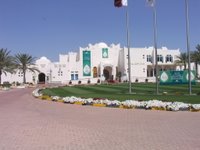


From a cosmetic standpoint, Qatar is very modern looking. There was a lot of construction underway while I was there. A fair amount of money was spent on artistic displays and statues.

Qatar however is far from "modern" from a social standpoint. In many ways, it is a very traditional Muslim country. They have very restrictive laws on speech. Despite the upper 80's temperature, we weren't allowed to wear shorts off base. We weren't allowed to take a picture of any building that had a Qatari flag on it nor were we allowed to take a picture of any Qatari citizens without their permission.
The day prior to the golf, I had a great experience eating a medium rare steak at Chiles (on the air base). Yeah, I know, that sounds lame. But, even though the meat wasn't the quality of a steakhouse back in the states, it was juicy with a pink center.

My mouth is watering just remembering it. Whenever the chow hall serves "steak" (and I use that term very loosely), it is always overcooked (well done and usually dry) and often kept warm by the fact that the steak is held in warm water. The other part of the restaurant experience that was neat is that I forgot (for an hour or so) that I was in the Middle East. It took me back to the feeling of being in any chain sit down restaurant in the states. Again, I know that probably sounds lame, but it was nice to get away (at least psychologically) from the constant reminders of conflict in the Middle East.
Here are a few more pictures:
18 March 2006
Combat Lifesavers
The combat lifesaver is taught advanced techniques in casualty assessment, hemorrhage control, and the treatment of tension pneumothorax. Among other training, the combat lifesavers are also taught basic techniques on casualty stabilization and administering IV fluids.
I am a big proponent of combat lifesavers and combat lifesaver training. I personally went through the training and certification a few months back. Well over half of my company is also trained and certified. Time and time again as indicated in after actions reports involving injuries, one of the first things soldiers mention about the incident is that they were so glad that they had a combat lifesaver in the gun truck.
08 March 2006
The Chatter
Often times, when one experiences something new and incredible, there's a strong desire to tell other people about it. Yes, I know, we're very social creatures. But what I've witnessed (and personally experienced) here is somewhat different than what I've seen on the civilian side. Or, at least is expressed more intensely here--almost an uncontrollable feeling to communicate with fellow soldiers. Let me give a few examples.
One soldier in my company just got back from a mission and it was the first time that he had ever encountered AIF. The soldier is rather shy and not very talkative. But upon returning from this mission, he wouldn't shut up for two days (and I am not exaggerating). He would go on at length about the mission, the small arms fire and the mortar rounds that they took. But it didn't stop there. He would talk about other stuff as well and became much more aggressive in his conversation style. He returned back to his normal self though after a couple of days.
Another example. We had a soldier who got back from a mission at about 2300 one night. During the mission (which lasted about 9-10 days), one of the HMMWV's in front of his was slightly hit by an IED. The driver though lost control of the vehicle and flipped it as they were going about 30-40 mph. No serious injuries thankfully. My soldier witnessed the whole thing as it unfolded. This same soldier also took small arms fire on more than one occasion on this mission. The soldier was still on adrenalin upon his return (even though the events occurred several nights prior). I don't think he even went to bed that night he returned. He told everybody that he saw that night about his mission and what he experienced. This continued for a day or two afterwards. Again, nonstop talking.
What I've noticed that is common among soldiers who exhibit the Chatter is that it occurs most often when soldiers run into the enemy for the first time (or after one of the first few times). The soldier exhibits unusually high levels of exhilaration, excitement, and intensity. In talking to the soldiers, there's also a sense of relief that they made it through the event (or series of events) without serious harm.
Based on my experiences and what I've taken from discussions with other soldiers, my guess is that the Chatter is a combination of a coping mechanism, a soldier bonding mechanism, and an expression of relief following the years of training that the soldier had in preparation of the day he first met the enemy.
I'm sure my observations are not new. But, it's still interesting for me to witness nonetheless. It's also interesting to know that despite all the differences that we have as humans (or at least Americans), there are definitely common behavioral characteristics that almost all of us share. And, the Chatter seems to be one of them.
02 March 2006
BIAP and Al Faw Palace
February was a busy month for me (about 3 weeks of various kinds of missions in Iraq). On one of the missions, I had another delay. This time it was in BIAP (f/k/a Sadaam Hussein International Airport). BIAP now not only houses the Baghdad International Airport but also at least three other significant military camps: Camp Victory, Camp Striker, and Camp Liberty. I believe there are a couple of other small camps as well (such as Seitz), but the three that I named are the main ones. The camps are adjacent to one another and for the most part one can travel freely between them.
The overall area is fairly large—I’d guess somewhere between 75-100 square kilometers. It’s situated in the southwestern portion of Baghdad. Three of my crews and I spent a couple hours at the Al Faw Palace, which is what I’ll mostly elaborate on with this post.
The palace itself is built around a man-made lake that is stocked with carp. Here are post card pictures of the palace:
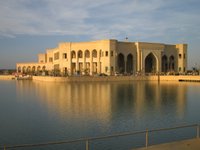
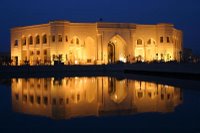

Around the perimeter of the lake is a path that’s roughly 2-2½ miles. There are a number of resort-type buildings there that I’m sure housed the buddies of the man who stopped his hunger strike because he got hungry (i.e., the power hungry sadistic dictator formerly known as President Hussein).
Below are some more pictures of the palace. The outside area and the front door:




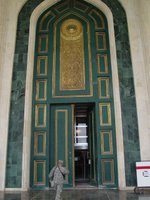
Inside the door of the palace, there's a brief history of the place:

Here's one of the towers that seen better days (prior to 2003).

There are some fairly impressive bathroom facilities in this palace. Here's one of the common areas for a bathroom:

Off of the common area, there are a number of smaller "private" rooms. Here's one:
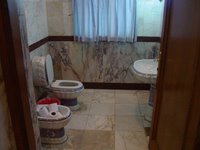
While they probably don’t rival those of certain Chinese-built facilities made for a certain former first lady, they are sure better than the porta-johns that I’ve become well acquainted with over here.
Here are some pictures of the walls, ceilings, and chandeliers:
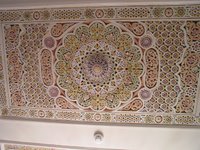




And here’s the chair that I plan to bring back to the office with me.
 Hopefully, there will be room.
Hopefully, there will be room.10 February 2006
A Commander's Stress
I got dressed and went to the TOC. It was business as usual there. Soldiers in the TOC were dealing with the typical late night/early morning cases of small arms fire and IEDs that were “close.” I looked at the clock, 0145. “What’s the deal with my guys, you got an update?” I asked. “They called in a MedEvac, one casualty was ‘urgent’ and one was ‘priority,’” the battle captain replied. “Was one of my guys injured?” I quickly jumped in as he was speaking. “We don’t know yet, but we don’t think so,” he replied. “We’re trying to find out,” he said.
An “urgent” casualty is one that must be evacuated within two hours or he will either lose life, limb or eyesight. A “priority” casualty is one that must be evacuated within six hours or he will lose life, limb or eyesight.
When units are far away, we typically rely on a communications system that is something like a civilian version of instant messaging. It’s not as quick or complete as the radio but it’s secure and it works well over long distances. In situations like this, it’s important to have “tactical patience” when in the back collecting information. The first priority of soldiers on the scene is to address the situation at hand. Considering where these guys were at the time, they were likely focusing on securing the area of operation, stabilizing the injured soldiers, and marking the landing zone for the helicopter. I’ve been there and I know what it’s like when some guy in the rear is clamoring for information and I’m trying to address the situation on the scene.
I looked at the clock again. 0153. Tactical patience, tactical patience, tactical patience, I was thinking to myself. We got a message back indicating that the vehicle that was directly hit (and had the soldiers with the injuries) was a gun truck from the other unit. They apparently took an extra gun truck on the mission. I admit, I was relieved. It was quickly followed by a feeling of guilt knowing that I was relieved. Two other U.S. soldiers were seriously injured. They weren’t my soldiers, but I’m sure they were someone’s husband, dad, son . . . .
I asked a TOC NCO to send them a message asking whether the MedEvac was there yet. Strong winds, blowing sand and rain were anticipated sometime during the early morning hours that day. I wasn’t sure whether it had hit yet. This could have a significant impact on whether they could get the injured soldiers out via helicopter.
I looked up at the clock. It was 0207 and we hadn’t heard a reply yet. Thoughts were racing through my head as to what they were likely doing, the training that they had been through, and what the crews on site had already been through with IEDs, mortars and small arms fire in the past. I knew these guys. I knew what they were capable of. I knew they were prepared. I was confident in the leadership on the site.
0215, still no reply. I decided to plot their position on the map. I quickly discovered that the route that they were on was coded impassable earlier that day because of AIF activity and road conditions and according to the most recent information we had at the time, it was still coded that way. I asked the battle captain why they were on that route. He said he didn’t know. We later found out that the operations center where the convoy originated from at the beginning of the convoy apparently had “better” information and chose that route for them.
I looked at the clock again, 0221. We received a message that the bird hadn’t landed yet. This was getting to be an issue because it had been just over an hour since the incident and I’m sure the soldiers were getting anxious about getting that Urgent casualty out of there. I remembered back when we were manifesting (deciding who was going to go on this particular mission). Because of room constraints, I was debating on whether to include one of our medics on this trip. I smiled knowing that we decided to include a good medic on this mission. I imagined him rendering aid to the injured soldiers. Performing tasks that he was trained to do. I also thought about how much stress he was probably under waiting for that bird for over an hour. I was glad though that those soldiers were probably getting the best dog-gone combat medic treatment that they could possibly get.
The battle captain looked over at me. Probably realizing that I was starting to stress just waiting, he said, “want to play darts?” “Darts?” I laughed under my breath. “Yeah,” he said. Why not I thought. We started to play. After every turn, I looked at the clock and then the electronic message board.
Then, at 0235, we got a message, the bird had lifted off with the injured soldiers on board. What a sense of relief I felt. We didn’t get a status of the injured soldiers but I felt better that the helicopter was able to land and pick them up and get them to the hospital. The message also indicated that they were in the process of trying to secure the damaged gun truck. They had been on the ground for well over an hour. My concern was shifting to their vulnerability just standing there on that route for a long period of time. I then sent a message to my head NCO at the IED site. I wanted to reassure him and let him know that I was there at the TOC.
0250 and they were still at the IED site. We received some additional information about the damage to the vehicle and the tactics used by the AIF with the IED. The AIF ran away like they usually do. The mechanics were finishing up their work.
By 0310, they were back on the road, heading to an interim destination in order for the damaged gun truck to be further worked on. I decided to head back to my tent. I told the battle captain to wake me if anything else happened with that convoy. As I walked out of the TOC, I thought again about the training my soldiers went through. I tried to figure out if there were ways for me to ensure my soldiers were even better prepared the next time. What training should I emphasize in the coming months? What equipment should I try to obtain for them to enable them to do their jobs better?
I didn’t sleep much the rest of that morning.
04 February 2006
Ur
The most visible dwelling in the area is the Ziggurat. It stands about 70 feet tall. Here are pictures of the Ziggurat from afar and one with me running up its steps:
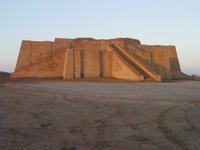


The Ziggurat was built around 2100 B.C. One thing that I found interesting was that the structure itself is solid. That is, it has no rooms or open areas inside. According to Muhsen, the Ziggurat was built by the Sumerians as a way in which to be closer go the god of the moon. The moon god was suppose to come from the sky and walk down the steps of the Ziggurat to be with the people. The Ziggurat itself was uncovered in the mid-1800's by the British. Apparently, there was at least one more level above the current Ziggurat structure that didn't survive the excavation.
Most of the structures at the city of Ur site are original. Muhsen said that the bricks in the public buildings (like the Ziggurat) are held together with a natural tar-like substance. Because the substance was so expensive back then, private buildings (such as dwellings) often used instead a mud-based substance to hold the bricks together. Here’s a picture of Muhsen explaining some of the details about how the buildings were made:
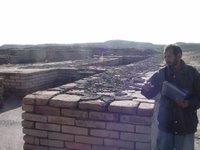
Below are several things “of note” at the site that I thought were fascinating:
*The site had many examples of ancient cuneiform writing, which according to Muhsen predates hieroglyphics. Here’s a sample:

*Small sea shells from one of the two floods (estimated to have occurred around 4000 B.C. and 2900 B.C.) were all over the place. It was strange to see small sea shells not on the sea shore but on the desert floor instead. :-)
*There were several tombs of kings in which 50 or so servants were buried alive (apparently voluntarily). Here are a number of pictures.

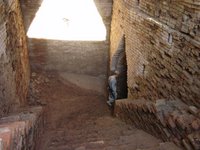
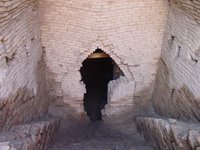

Compare those pictures of tombs with a picture of a tomb of a “common” person, not much higher than mid-thigh:

*The world’s first arch according Muhsen (or perhaps oldest intact?) is located on the site. Here’s a picture:

*There was also a structure the Muhsen said was the first museum. It was a structure that housed a collection of items from earlier times that was put on display for others to see. Here’s a picture of that building:

(the cement on top was put there in the 1990s to preserve the structure in anticipation of a visit from the Pope).
*Finally, we looked at the house of Abraham. The house itself was rebuilt. When they dug up the ruins, all that was left from the site was the foundation and the floors. So, they rebuild the ground floor walls. Apparently, Abraham was fairly well off primarily because of his father’s success as a businessman. According to Muhsen, Abraham’s father earned money by selling idols. That’s ironic. Anyway, Abraham’s house was fairly large. It consisted of more than one level, which wasn’t common for a dwelling back then in that area. The pictures below are of the dwelling, including one with soldiers walking on the walls that formed the basis for the second floor.
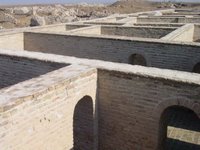

Back in the day, the Euphrates River flowed near the city walls of Ur. According to Muhsen, the city reached a population of somewhere between 250,000 and 500,000. By around 400 B.C. though, the city was deserted. It is thought that the reason for this was the shifting of the Euphrates River. Prior to the shifting of the river, there apparently was grass, trees and a significant amount of vegetation. My, how times have changed.
29 January 2006
Flood


The Iraq-Kuwait border was hit pretty hard too:

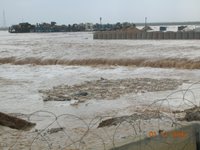

For us, it caused just inconveniences—detours, items on floors getting wet, some periods of lost electricity, etc. But in Safwan, there were a lot more than just inconveniences. Here are some pictures that were taken about 4 or 5 days after the rain:
Over 150 homes were lost (homes typically house 10-14 extended family members). A refugee tent area was sent up in the city to house those left homeless from the flood. Here are some more pictures:

Without a public sewer system, there were fears that the flood would cause disease outbreaks. Thankfully, nothing significant happened.








